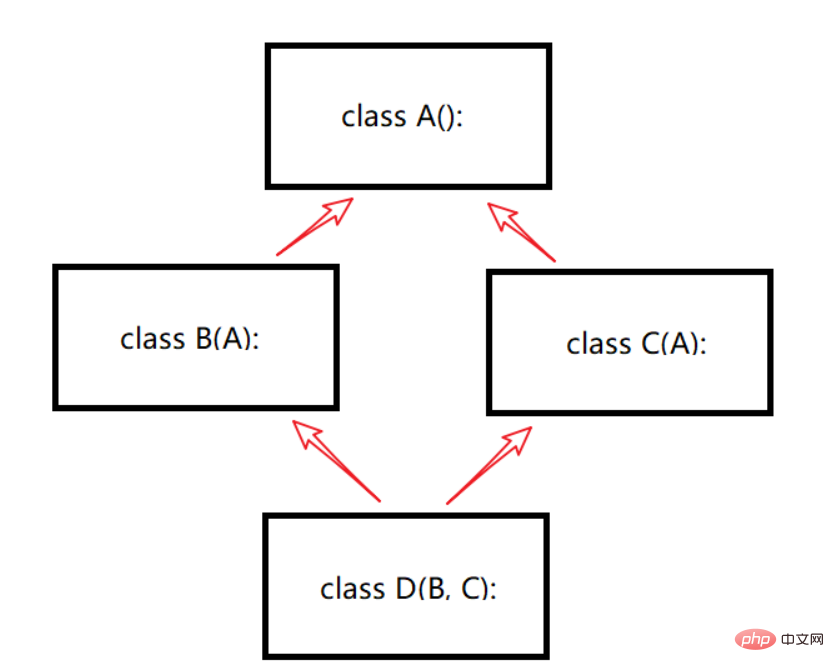Diamond inheritance in Python multiple inheritance
This article introduces the usage of diamond inheritance in Python multiple inheritance. I hope it will be helpful to friends who are learning Python!

Inheritance is an important method of object-oriented programming. Through inheritance, subclasses can extend the functions of parent classes. In python, a class can inherit from more than one parent class. This is called python's Multiple Inheritance (Multiple Inheritance).
Syntax
class SubclassName(BaseClass1, BaseClass2, BaseClass3, ...):
passRhombus inheritance
Recommended learning: Python video tutorial
Inheritance at multiple levels When used together with multiple inheritance, complex inheritance relationships will appear, such as multiple inheritance.
Among them, diamond inheritance will appear. As shown below. 
In this structure, there are doubts about the calling order. Which of the following is the calling order?
- D-> B->A->C (depth first)
- D->B->C->A (breadth first)
Let’s answer this question.
Let’s take an example:
class A():
def __init__(self):
print('init A...')
print('end A...')
class B(A):
def __init__(self):
print('init B...')
A.__init__(self)
print('end B...')
class C(A):
def __init__(self):
print('init C...')
A.__init__(self)
print('end C...')
class D(B, C):
def __init__(self):
print('init D...')
B.__init__(self)
C.__init__(self)
print('end D...')
if __name__ == '__main__':
D()Output result
init D... init B... init A... end A... end B... init C... init A... end A... end C... end D...
From the output result, the calling sequence is: D->B->A-> ;C->A. It can be seen that B and C jointly inherit from A, and A is called twice. There is no need to call A twice.
Actually, the root causes of the above problems are all related to MRO. MRO (Method Resolution Order) is also called Method Resolution Order, which is mainly used to determine the resolution during multiple inheritance. Which class does the attribute come from? It uses an algorithm called C3. The basic idea is that uses breadth first and left to right on the premise of avoiding the same class being called multiple times. principles to find the required properties and methods.
So how to prevent a method in the top-level parent class from being called multiple times? Super() is needed at this time. Super is essentially a class that records MRO information internally. , since the C3 algorithm ensures that the same class will only be searched once, thus avoiding the method in the top-level parent class from being executed multiple times, the above code can be changed to:
class A():
def __init__(self):
print('init A...')
print('end A...')
class B(A):
def __init__(self):
print('init B...')
super(B, self).__init__()
print('end B...')
class C(A):
def __init__(self):
print('init C...')
super(C, self).__init__()
print('end C...')
class D(B, C):
def __init__(self):
print('init D...')
super(D, self).__init__()
print('end D...')
if __name__ == '__main__':
D()Output result:
init D... init B... init C... init A... end A... end C... end B... end D...
It can be seen that the calling sequence at this time is D->B->C->A. That is, the breadth-first traversal method is used.
Supplementary content
Python classes are divided into two types, one is called classic class, and the other is called new style class. Both support multiple inheritance, but the order of inheritance is different.
- New style class: Class inherited from object. (For example: class A(object)), inherited using breadth-first search (that is, horizontal search first, then upward search).
- Classic class: A class that does not inherit from object. (For example: class A()), inherit using depth-first search method (that is, first go deep into the left side of the inheritance tree, then return, and then find the right side).
There are two types of classes in Python 2.x: classic classes and new classes. Python3.x is full of new-style classes.
For more python related tutorials, please pay attention to the python tutorial column.
The above is the detailed content of Diamond inheritance in Python multiple inheritance. For more information, please follow other related articles on the PHP Chinese website!

Hot AI Tools

Undresser.AI Undress
AI-powered app for creating realistic nude photos

AI Clothes Remover
Online AI tool for removing clothes from photos.

Undress AI Tool
Undress images for free

Clothoff.io
AI clothes remover

AI Hentai Generator
Generate AI Hentai for free.

Hot Article

Hot Tools

Notepad++7.3.1
Easy-to-use and free code editor

SublimeText3 Chinese version
Chinese version, very easy to use

Zend Studio 13.0.1
Powerful PHP integrated development environment

Dreamweaver CS6
Visual web development tools

SublimeText3 Mac version
God-level code editing software (SublimeText3)

Hot Topics
 1378
1378
 52
52
 HadiDB: A lightweight, horizontally scalable database in Python
Apr 08, 2025 pm 06:12 PM
HadiDB: A lightweight, horizontally scalable database in Python
Apr 08, 2025 pm 06:12 PM
HadiDB: A lightweight, high-level scalable Python database HadiDB (hadidb) is a lightweight database written in Python, with a high level of scalability. Install HadiDB using pip installation: pipinstallhadidb User Management Create user: createuser() method to create a new user. The authentication() method authenticates the user's identity. fromhadidb.operationimportuseruser_obj=user("admin","admin")user_obj.
 Python: Exploring Its Primary Applications
Apr 10, 2025 am 09:41 AM
Python: Exploring Its Primary Applications
Apr 10, 2025 am 09:41 AM
Python is widely used in the fields of web development, data science, machine learning, automation and scripting. 1) In web development, Django and Flask frameworks simplify the development process. 2) In the fields of data science and machine learning, NumPy, Pandas, Scikit-learn and TensorFlow libraries provide strong support. 3) In terms of automation and scripting, Python is suitable for tasks such as automated testing and system management.
 The 2-Hour Python Plan: A Realistic Approach
Apr 11, 2025 am 12:04 AM
The 2-Hour Python Plan: A Realistic Approach
Apr 11, 2025 am 12:04 AM
You can learn basic programming concepts and skills of Python within 2 hours. 1. Learn variables and data types, 2. Master control flow (conditional statements and loops), 3. Understand the definition and use of functions, 4. Quickly get started with Python programming through simple examples and code snippets.
 Navicat's method to view MongoDB database password
Apr 08, 2025 pm 09:39 PM
Navicat's method to view MongoDB database password
Apr 08, 2025 pm 09:39 PM
It is impossible to view MongoDB password directly through Navicat because it is stored as hash values. How to retrieve lost passwords: 1. Reset passwords; 2. Check configuration files (may contain hash values); 3. Check codes (may hardcode passwords).
 How to optimize MySQL performance for high-load applications?
Apr 08, 2025 pm 06:03 PM
How to optimize MySQL performance for high-load applications?
Apr 08, 2025 pm 06:03 PM
MySQL database performance optimization guide In resource-intensive applications, MySQL database plays a crucial role and is responsible for managing massive transactions. However, as the scale of application expands, database performance bottlenecks often become a constraint. This article will explore a series of effective MySQL performance optimization strategies to ensure that your application remains efficient and responsive under high loads. We will combine actual cases to explain in-depth key technologies such as indexing, query optimization, database design and caching. 1. Database architecture design and optimized database architecture is the cornerstone of MySQL performance optimization. Here are some core principles: Selecting the right data type and selecting the smallest data type that meets the needs can not only save storage space, but also improve data processing speed.
 How to use AWS Glue crawler with Amazon Athena
Apr 09, 2025 pm 03:09 PM
How to use AWS Glue crawler with Amazon Athena
Apr 09, 2025 pm 03:09 PM
As a data professional, you need to process large amounts of data from various sources. This can pose challenges to data management and analysis. Fortunately, two AWS services can help: AWS Glue and Amazon Athena.
 How to start the server with redis
Apr 10, 2025 pm 08:12 PM
How to start the server with redis
Apr 10, 2025 pm 08:12 PM
The steps to start a Redis server include: Install Redis according to the operating system. Start the Redis service via redis-server (Linux/macOS) or redis-server.exe (Windows). Use the redis-cli ping (Linux/macOS) or redis-cli.exe ping (Windows) command to check the service status. Use a Redis client, such as redis-cli, Python, or Node.js, to access the server.
 How to read redis queue
Apr 10, 2025 pm 10:12 PM
How to read redis queue
Apr 10, 2025 pm 10:12 PM
To read a queue from Redis, you need to get the queue name, read the elements using the LPOP command, and process the empty queue. The specific steps are as follows: Get the queue name: name it with the prefix of "queue:" such as "queue:my-queue". Use the LPOP command: Eject the element from the head of the queue and return its value, such as LPOP queue:my-queue. Processing empty queues: If the queue is empty, LPOP returns nil, and you can check whether the queue exists before reading the element.




